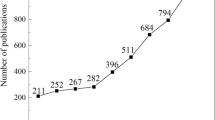Abstract
Lightning is the main cause of transmission system outages, affecting reliability of power supply and resulting in economic losses. Shielding failure is an important issue in addressing the lightning performance of overhead transmission lines. In this paper an improved method based on the electro-geometric model is proposed to evaluate the shielding failure flashover rate (SFFOR) of transmission lines, considering the influences of landform, lightning polarity and stroke angle. In the improved method, the striking distances to phase conductors, shield wires and ground are properly differentiated by using recent equations developed to take into account other factors not only magnitude of lightning strokes. These factors include height of wires as well as lightning polarity. To reflect the effects of changes in terrain and height of wires on SFFOR, a method for identifying the topography and the relative position among the wires and ground is proposed. A 400-kV double-circuit transmission line section in complex terrain area was taken as example, and the results show that this method can reflect changes of the SFFOR along the span and can be useful to figure out which towers are easy to be struck by lightning along the entire transmission line. This research is helpful for the design and operation of overhead transmission lines.














Similar content being viewed by others
References
IEEE, Std. 1243 (1997) IEEE guide for improving the lightning performance of transmission lines. Transmission and Distribution Committee of the IEEE Power Engineering Society, New York
Cooray V, Pérez H (1994) Some features of lightning flashes observed in Sweden. J Geophys Res 99(D5):10683–10688
Martínez Velasco JA, Castro Aranda F (2006) Lightning characterization for flashover rate calculation of overhead transmission lines. In: IEEE power engineering society general meeting 2006. Montreal, Canada, p 6
Rakov V, Uman M, Thottappillil R (1994) Review of lightning properties from electric field and TV observations. J Geophys Res 99(D5):10745–10750
Chisholm WA (2001) The IEEE flash program: a structure for evaluation of transmission lightning performance. Trans Electr Electron Eng 121–B(8):914–917
Visacro S, Dias R, Mesquita C (2005) Novel approach for determining spots of critical lightning performance along transmission lines. IEEE Trans Power Deliv 20(2):1459–1464
Grzybowski S, Thongchai D, (2010) Laboratory investigation of lightning striking distance to rod and transmission line (invited). In, (2010) Asia-Pacific international symposium on electromagnetic compatibility. Beijing, China
Uman MA (2008) The science of lightning protection. Cambridge University Press, Cambridge
Love R (1973) Improvements on lightning strokes modeling and applications to the design of EHV and UHV transmission lines. University of Colorado, Denver
Wagner CF, Hileman AR (1961) The lightning stroke-II. Power apparatus and systems, part III. Trans Am Inst. Electr Eng 80(3):622–636
Whitehead E (1974) CIGRE survey of the lightning performance of EHV transmission lines. Electra 27:63–69
Anderson JG (1982) Lightning performance of transmission lines. In: Transmission line reference book—345 kV and above. Electric Power Research Institute (EPRI, (ed) LaForest JJ, Editorial committee: Comber MG, Zaffanelia LE. Palo Alto, California, pp 545–597
Brown GW, Whitehead ER (1969) Field and analytical studies of transmission line shielding: part II. IEEE Trans Power Appar Syst 88(5):617–626
Young F, Clayton J, Hileman A (1963) Shielding of transmission lines. AIEE Trans Power Appar Syst S 82(63):132–154
Mikropoulos P, Tsovilis T (2008) Striking distance and interception probability. IEEE Trans Power Deliv 23(3):1571–1580
Eriksson AJ (1987) An improved electrogeometric model for transmission line shielding analysis. IEEE Trans Power Deliv 2(3):871–886
Rizk FAM (1990) Modeling of transmission line exposure to direct lightning strokes. IEEE Trans Power Deliv 5(4):1983–1997
Liu HJ et al (2011) Research on shielding failure rated for transmission lines considering working voltage. Lecture notes in electrical engineering: future intelligent information systems 86(1):585–590
Ríos JB (2004) Líneas de transmisión de potencia. In: Aspectos mecánicos y conductores, Lima, Perú
Martínez Velasco JA, Castro Aranda F (2006) Influence of the stroke angle on the flashover rate of an overhead transmission line. IEEE power engineering society general meeting. Montreal, Canada, pp 1–6
Shafaei A, Gholami A, Reza S (2011) Advanced statistical method for evaluating of lightning performance of overhead transmission lines based on accurate modelling and considering non-vertical strokes. Canadian conference on electrical and computer engineering, CCECE 2011. Niagara Falls, Canada, pp 739–744
Chang M, Gailian Y (2010) Analysis for calculation method of shielding flashover rate on common-tower double transmission line. In: China international conference on electricity distribution—CICED 2010, Nanjing, China
Ouchi K et al (1997) Observation of lightning at 500 kV transmission lines (part 1). IEEJ Trans Power Energy 117(12):1561–1567
IEEE (1993) Estimating lightning performance of transmission lines II–updates to analytical models. IEEE Trans Power Deliv 8(3):1254–1267
IEEE (2005) Parameters of lightning strokes: a review. IEEE Trans Power Deliv 20(1):346–358
ICONTEC (2008) NTC 4552-1: Protección contra descargas eléctricas atmosféricas (Rayos). Parte 1: Principios generales, Bogotá, Colombia
Mikropoulos PN, Tsovilis TE, Zlitidis DE (2010) Software development for the evaluation of the lightning performance of overhead transmission lines. In: 45th international universities’ power engineering conference (UPEC (2010) Cardiff. Wales, UK
Vargas M, Torres H (2008) Lightning leader model for straight, tortuous or branched channels–part II: model results. J Electrostat 66:489–495
Vargas M, Torres H (2008) Lightning leader model for straight, tortuous or branched channels–part I: model description. J Electrostat 66:482–488
Acknowledgements
Main author would like to thank Emelson Jimenez for his contributions and support with the scholarship. Authors would like to thank Universidad del Norte for the support.
Author information
Authors and Affiliations
Corresponding author
Rights and permissions
About this article
Cite this article
Jimenez, V., Montaña, J., Candelo, J. et al. Estimation of the shielding performance of transmission lines considering effects of landform, lightning polarity and stroke angle. Electr Eng 100, 425–434 (2018). https://doi.org/10.1007/s00202-017-0517-3
Received:
Accepted:
Published:
Issue Date:
DOI: https://doi.org/10.1007/s00202-017-0517-3




